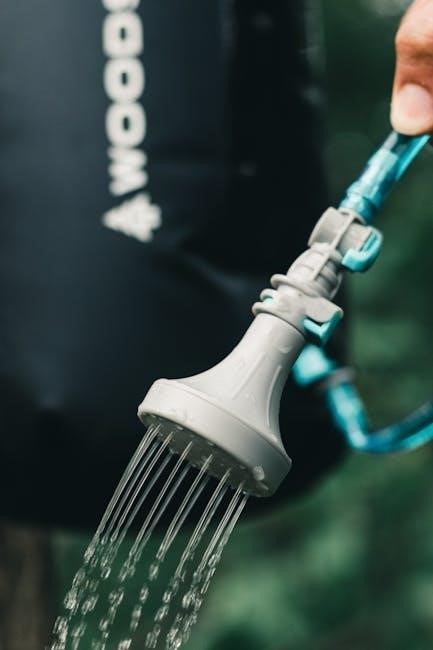The Hormann Supramatic E is a high-efficiency garage door opener designed for seamless operation and durability. Engineered in Germany, it offers advanced features like energy-saving LED lighting and smart home compatibility, ensuring convenience and security for modern households.
1.1. Overview of the Hormann Supramatic E Garage Door Opener
The Hormann Supramatic E is a premium garage door opener designed for efficiency and reliability. It features advanced German engineering, offering quiet operation and robust performance. Equipped with energy-efficient LED lighting, it ensures even illumination in your garage. The system is compatible with smart home integration, allowing seamless control via smartphone apps. Its compact design and whisper-quiet functionality make it ideal for modern homes. The Supramatic E is built to last, with durable components and a user-friendly interface. It supports sectional and up-and-over doors, ensuring versatility for various garage setups. This opener combines innovation, safety, and convenience, making it a top choice for homeowners.
1.2. Key Features and Benefits
The Hormann Supramatic E boasts advanced features such as energy-efficient LED lighting, which provides even garage illumination while reducing power consumption. Its smart home integration capability allows users to control the door via smartphone apps, enhancing convenience and security. The system includes a manual override for emergencies and child safety features for added protection; Designed for durability, it operates quietly and smoothly, ensuring long-term reliability. These features make the Supramatic E a versatile and modern solution for garage door automation, offering both practicality and innovation to enhance daily functionality and user satisfaction.
1.3. Importance of Following the Instruction Manual
Adhering to the Hormann Supramatic E instruction manual is crucial for safe and proper installation, operation, and maintenance. The manual provides detailed guidance on compatibility checks, safety protocols, and troubleshooting, ensuring the system functions optimally. Incorrect installation or operation can lead to malfunctions, safety hazards, or damage to the door and opener. By following the manual, users can prevent potential risks, extend the product’s lifespan, and enjoy hassle-free performance. It also highlights essential safety features and maintenance routines, making it a vital resource for both installers and homeowners to maximize the system’s efficiency and reliability over time.

Pre-Installation Requirements
Before installing the Hormann Supramatic E, ensure the garage door is compatible and properly balanced. Check for required clearances and prepare the installation site according to the manual.
2.1. Compatibility Check for Garage Doors
The Hormann Supramatic E is designed for spring-balanced up-and-over and sectional garage doors. Ensure your door type matches these specifications before installation. The operator is not suitable for doors with stiff movement or those that cannot open/close smoothly. Verify the door’s weight and dimensions align with the opener’s capacity, as outlined in the manual, to ensure proper function and safety. Incorrect compatibility may lead to operational issues or damage. Always refer to the instruction manual for specific requirements and guidelines to avoid potential problems during installation or use.
2.2. Safety Precautions Before Installation
Before installing the Hormann Supramatic E, ensure the garage door is properly balanced and securely fastened to prevent accidents. Disconnect the power supply to avoid electrical hazards. Remove any loose objects that could interfere with the installation process. Keep children and pets away from the work area. Always wear protective gear, such as gloves and safety glasses, to prevent injury; Follow the manual’s guidelines strictly, as improper installation can lead to malfunctions or safety risks. Double-check all components for damage before use and ensure the door’s spring tension is correct to maintain smooth operation.
2.3. Tools and Materials Needed
To install the Hormann Supramatic E, you will need a set of basic tools and materials. Essential tools include a screwdriver, wrench, pliers, and a drill with appropriate bits. Materials such as wall anchors, screws, and bolts are required for secure mounting. Ensure you have the provided mounting brackets, rail system, and motor unit. Additional items like a ladder or step stool may be necessary for safe access. Always refer to the instruction manual for specific hardware requirements to ensure compatibility and proper installation. Gathering all necessary tools and materials beforehand will streamline the installation process and prevent delays.

Installation Process
The Hormann Supramatic E installation involves mounting the motor, aligning the rail system, and securing all components. Follow the manual for precise steps to ensure proper setup and functionality.
3.1. Step-by-Step Installation Guide
Begin by unpacking and preparing all components, ensuring compatibility with your garage door. Mount the motor unit securely, following the manual’s alignment guidelines. Next, attach the rail system to the door and garage ceiling, ensuring proper leveling. Connect the motor to the rail and install the safety sensors. Proceed with wiring, connecting the motor to a power source and integrating any additional accessories. Finally, test the system thoroughly to ensure smooth operation. Always refer to the manual for specific torque settings and electrical connections to avoid damage or safety hazards.
3.2. Mounting the Operator and Rail System
Mount the operator securely to the garage ceiling, ensuring it is level and properly aligned with the door. Attach the rail system to the door’s top section, following the manufacturer’s specifications. Use the provided brackets to connect the rail to the operator, ensuring all bolts are tightened to the recommended torque. Double-check the alignment to prevent misoperation. If installing on a sectional door, ensure the rail is correctly latched to each panel. Proper mounting is crucial for smooth and safe operation. Refer to the manual for detailed diagrams and specific instructions to avoid installation errors.
3.3. Wiring and Electrical Connections
Connect the operator to a 230V power supply using a dedicated circuit. Ensure all wires are securely attached to the control panel and sensors. Follow the wiring diagram in the manual to connect the emergency release, safety sensors, and wall button. Properly ground the system to prevent electrical hazards. Test the connections to ensure smooth operation. If unsure, consult a licensed electrician to avoid safety risks. Always refer to the manual for specific wiring instructions tailored to your Hormann Supramatic E model. Incorrect wiring can lead to malfunctions or safety issues, so attention to detail is crucial during this step.
3.4. Testing the Door After Installation
After completing the installation, test the Hormann Supramatic E thoroughly to ensure proper functionality. Start by manually opening and closing the door to check smooth operation. Use the remote control and wall button to verify response times and accuracy. Test the safety sensors by obstructing the door’s path during operation to ensure it stops or reverses. Check the emergency release mechanism to confirm it disengages correctly. Review the manual for specific testing procedures tailored to your model. Proper testing ensures safety, efficiency, and longevity of the system. Any issues detected during testing should be addressed before regular use to prevent malfunctions.

Safety Instructions
Always follow safety guidelines to prevent accidents. Ensure the door area is clear, regularly inspect components, and avoid unauthorized adjustments. Use protective gear and ensure emergency features function correctly. Adhere to the manual’s instructions for safe operation and maintenance.

4.1. General Safety Guidelines
Always ensure the garage door area is clear of obstacles and people before operating. Regularly inspect door components for wear or damage. Avoid unauthorized adjustments to the opener, as this may compromise safety. Never allow children to play with the remote controls or door. Ensure proper installation and alignment of safety sensors to prevent accidents. Use protective gear when performing maintenance tasks. Follow all instructions in the manual carefully to maintain optimal safety. Keep emergency release mechanisms easily accessible and ensure they function correctly. Regularly test the door’s auto-reverse feature to ensure it stops or reverses upon encountering an obstruction.
4.2. Emergency Release Mechanism
The Hormann Supramatic E features an emergency release mechanism designed for safe manual operation during power failures or system malfunctions. Located near the door, it allows disengagement of the motor, enabling manual opening or closing. To activate, pull the red emergency release handle or cord firmly downward. Ensure the mechanism is easily accessible and not obstructed. Regularly test the release to confirm smooth operation. Avoid forcing the door open, as this may cause damage. Always re-engage the motor properly after use. Consult the manual or a professional if unsure about proper procedure to maintain safety and functionality.
4.3. Child Safety Features
The Hormann Supramatic E incorporates advanced child safety features to prevent accidents and ensure secure operation. The system includes obstacle detection sensors that automatically reverse the door’s movement if an object or person is detected. Additionally, the door is equipped with a secure locking mechanism to prevent unauthorized access. Parents can ensure their children’s safety by keeping remote controls out of reach and teaching them about proper door usage. Regularly test safety features to ensure functionality. These measures provide peace of mind for households with children, aligning with global safety standards and promoting a secure home environment.

Programming the Remote Control
Programming the Hormann Supramatic E remote control enables easy garage door operation. Follow the manual’s instructions to sync your remote with the opener. Additional remotes can be added for convenience.
5.1. Pairing the Remote Control with the Opener
To pair the remote control with the Hormann Supramatic E opener, locate the “LEARN” button on the motor unit. Press and hold it until the LED indicator flashes. Release the button and immediately press the desired remote control button. The LED will stop flashing once pairing is successful. Ensure the opener is in programming mode before starting. If pairing fails, repeat the process. Test the remote to confirm proper functionality. This process syncs the remote with the opener, enabling seamless garage door operation. Follow the manual for additional tips to ensure a secure and successful pairing process.
5.2. Setting Up Additional Remotes
To set up additional remotes for the Hormann Supramatic E, first activate the opener’s programming mode by pressing and holding the “LEARN” button until the LED flashes. Release the button and press the remote control button you wish to pair. The LED will stop flashing once the remote is successfully synced. Repeat this process for each additional remote. Ensure all remotes are tested to confirm proper functionality. This method allows multiple remotes to control the opener, providing convenience for all users. Always refer to the manual for specific pairing instructions to ensure compatibility and secure setup.
5.3. Resetting Remote Control Settings
To reset the remote control settings for the Hormann Supramatic E, first locate the “LEARN” button on the garage door opener. Press and hold this button until the LED light begins to blink. Once blinking, release the button and immediately press the desired button on the remote control you wish to reset. The LED will stop blinking once the reset is complete. This process ensures that the remote control’s settings are cleared and ready for reprogramming if needed. Always refer to the instruction manual for specific guidance to avoid any unintended effects on paired remotes or system functionality. Resetting helps resolve issues like signal interference or incorrect programming, ensuring smooth operation of your garage door opener.

Operating the Hormann Supramatic E
The Hormann Supramatic E operates smoothly, combining ease of use with reliability. Its advanced features enhance convenience, making daily garage door control efficient and hassle-free.
6.1. Daily Operation and Functionality
The Hormann Supramatic E ensures smooth and quiet operation, offering reliable performance for daily use. With its intuitive remote control and wall button, users can effortlessly open or close their garage door. The system features energy-efficient LED lighting, providing consistent illumination for enhanced visibility. It also supports smart home integration, allowing seamless control via compatible devices. Designed for safety, the opener includes advanced sensors to prevent accidents and ensure secure operation. Regular updates and maintenance, as outlined in the manual, are crucial to maintain optimal functionality and extend the lifespan of the system.
6.2. Manual Override in Case of Power Failure
In the event of a power outage, the Hormann Supramatic E features a manual override mechanism to ensure continued functionality. By locating the emergency release handle, users can disengage the door from the opener, allowing manual operation. This feature ensures easy door control, maintaining accessibility and security. Always ensure the door is balanced before manual operation to prevent potential hazards; Once power is restored, simply re-engage the opener to resume normal operation. This reliable system guarantees convenience and peace of mind during unexpected power failures, aligning with the product’s commitment to safety and user-friendly design.

Maintenance and Care
Regular maintenance ensures optimal performance of the Hormann Supramatic E. Clean the rail system and lubricate moving parts periodically. Inspect for wear and tear, and replace damaged components promptly to maintain efficiency and safety.
7.1. Regular Maintenance Schedule
Regular maintenance is essential to ensure the Hormann Supramatic E operates smoothly. Clean the rail system monthly to remove dirt and debris. Lubricate moving parts quarterly using a silicone-based spray to prevent friction. Inspect the door and opener for wear and tear, checking for loose screws or misaligned components. Replace any damaged parts promptly to avoid further issues. Additionally, test the door’s balance quarterly by disconnecting the opener and manually opening the door—it should move effortlessly. Schedule an annual professional inspection to ensure optimal performance and safety. Always refer to the manual for specific maintenance recommendations tailored to your system.
7.2. Cleaning and Lubrication Tips
Regular cleaning and lubrication are crucial for maintaining the Hormann Supramatic E’s performance. Use a soft cloth and mild detergent to wipe down the rail system and door panels, ensuring no dirt or grease accumulates. For lubrication, apply a silicone-based spray to moving parts like rollers and hinges every 3-6 months. Avoid oil-based products, as they attract dust. Clean the remote control with a dry cloth and mild alcohol solution. Also, ensure the LED light is free of dust for optimal illumination. Regular cleaning and lubrication prevent wear and tear, ensuring smooth operation and extending the system’s lifespan.

Troubleshooting Common Issues
Troubleshooting the Hormann Supramatic E involves addressing door malfunctions, remote control issues, and unusual noises. Check power supply, alignment, and obstructions. Refer to the manual for detailed solutions.
8.1. Door Not Opening or Closing Properly
If the Hormann Supramatic E fails to open or close properly, check for obstructions, alignment issues, or power supply problems. Ensure the door is balanced and the rail is clear. Verify limit settings and adjust them if necessary. Lubricate moving parts and inspect for wear. Consult the manual for detailed diagnostic steps and solutions. If issues persist, contact a professional technician for assistance.
8.2. Remote Control Not Responding
If the remote control isn’t responding, start by checking the battery level and replacing or charging it if necessary. Ensure there are no obstructions or interference from other devices. Re-pair the remote by pressing and holding the programming button until the LED lights up, then test operation. Consult the manual for specific pairing instructions. Verify that the opener recognizes the remote in its settings. If issues persist, reset the remote or contact a certified technician for further assistance.
8.3. Strange Noises During Operation
If strange noises occur during operation, inspect the door and opener for obstructions or misalignment. Lubricate moving parts like rollers and hinges to reduce friction. Check for loose screws or worn components and tighten or replace them as needed. Ensure the rail system is clean and free of debris. If the noise persists, verify that the door is balanced properly and the springs are functioning correctly. Power cycle the opener or reset it if necessary. Consult the manual or contact a professional technician for further diagnosis and repair to prevent potential damage to the system. Regular maintenance can help prevent such issues.

Advanced Features
The Hormann Supramatic E features energy-efficient LED lighting for improved visibility and smart home integration, allowing seamless control via compatible systems for enhanced convenience and modern functionality.
9.1. Energy-Efficient LED Lighting
The Hormann Supramatic E features energy-efficient LED lighting, designed to provide bright and consistent illumination in your garage. This eco-friendly solution reduces power consumption while ensuring reliability. The LED light automatically activates when the door opens, enhancing visibility and safety. With a long lifespan, the LED minimizes maintenance needs. It also contributes to energy savings, aligning with modern environmental standards. This feature is seamlessly integrated into the opener’s design, offering both functionality and efficiency. The LED lighting ensures your garage is well-lit, making it easier to navigate and perform tasks, while also reducing your overall energy usage over time.
9.2. Smart Home Integration Options
The Hormann Supramatic E supports seamless integration with smart home systems, offering enhanced control and convenience. Compatible with popular platforms like Apple HomeKit and Google Home Assistant, this feature allows users to operate their garage door via voice commands or smartphone apps. The opener can be connected to your home network via Wi-Fi or Bluetooth, enabling remote monitoring and automation. This integration simplifies daily routines, ensuring your garage door operates in harmony with other smart devices. Additionally, it provides real-time notifications for door status and movement, enhancing security and peace of mind. This feature makes the Supramatic E a modern, tech-savvy solution for garage door automation.
The Hormann Supramatic E is a reliable, efficient garage door opener designed for modern convenience. By following the manual, users ensure optimal performance, safety, and longevity of the system.
10.1. Final Tips for Optimal Performance
For optimal performance of the Hormann Supramatic E, ensure regular maintenance, including lubrication of moving parts and inspection of worn components. Always follow the manufacturer’s guidelines for adjustments and repairs. Proper alignment of the door and opener is crucial to prevent strain on the system. Avoid overloading the door with heavy accessories, as this can reduce efficiency. Regularly clean the rail system to ensure smooth operation. By adhering to these tips, you can extend the lifespan of your opener and maintain its efficiency and reliability over time. Consistent care will ensure your Hormann Supramatic E operates seamlessly for years to come.
10.2. Importance of Regular Updates and Maintenance
Regular updates and maintenance are essential to ensure the Hormann Supramatic E operates at peak performance. Firmware updates often include new features and bug fixes, enhancing functionality and security. Lubricating moving parts and checking electrical connections prevent wear and tear. Schedule annual professional inspections to identify potential issues early. Additionally, cleaning the door and opener components ensures smooth operation. By prioritizing maintenance, you protect your investment and extend the system’s lifespan. Regular care also reduces the risk of unexpected breakdowns, ensuring consistent reliability and safety for years to come. Stay proactive to keep your Hormann Supramatic E running efficiently and securely.






























